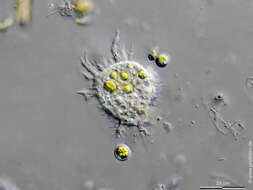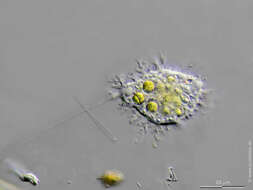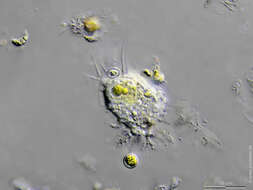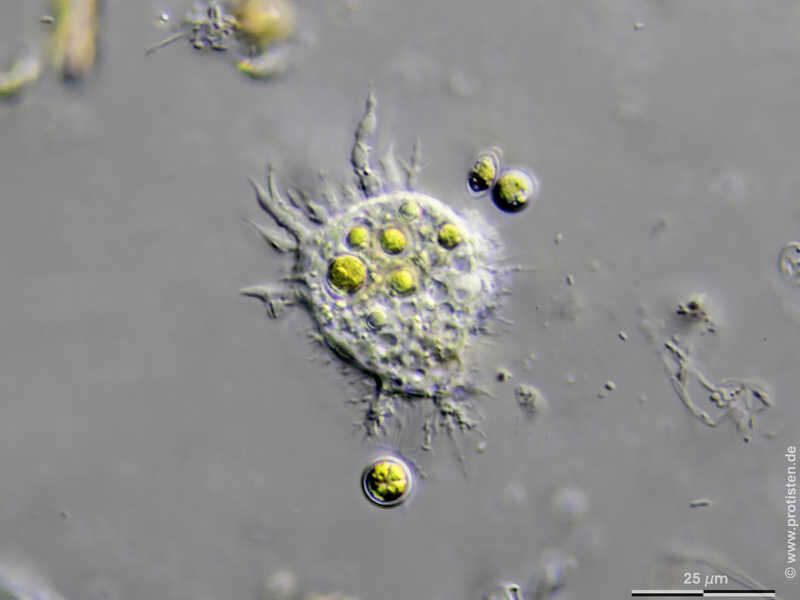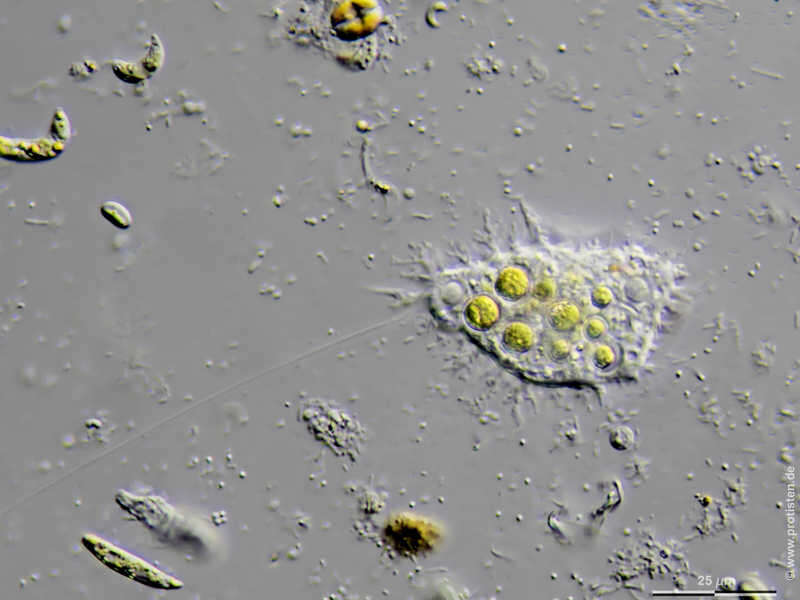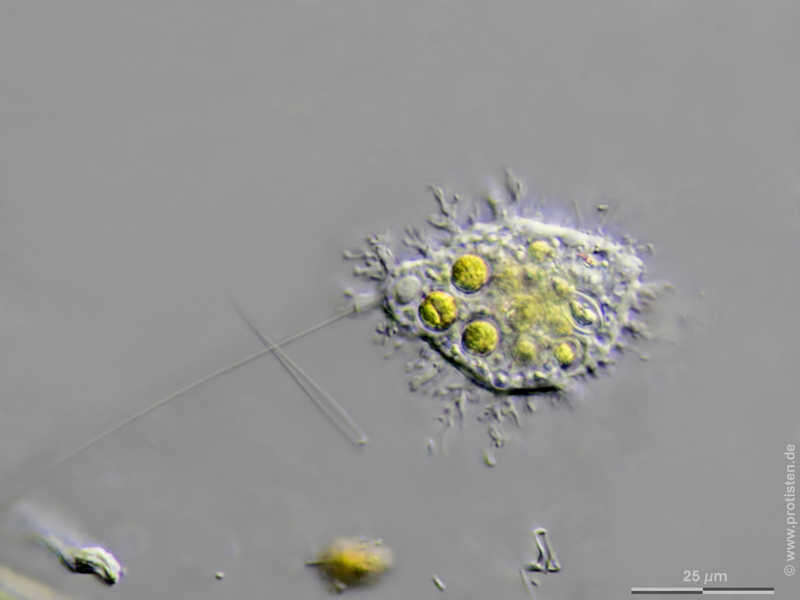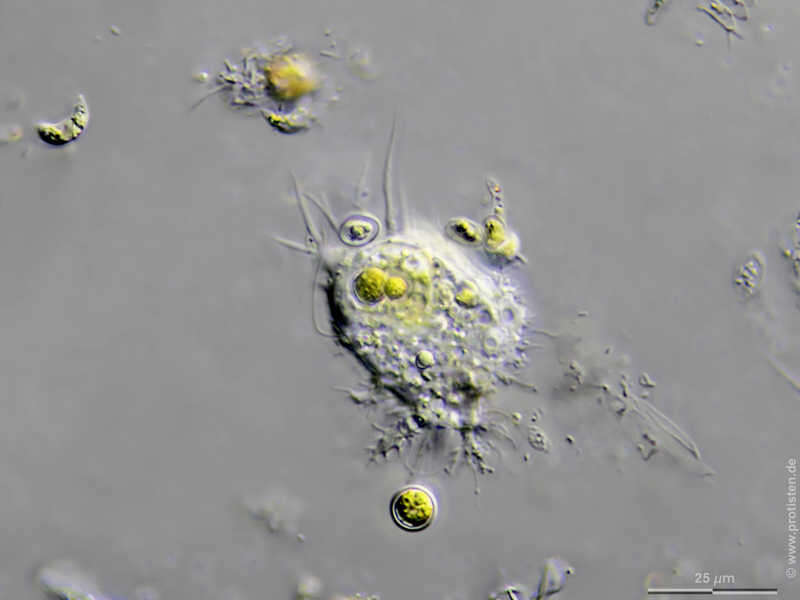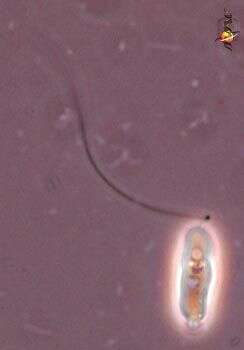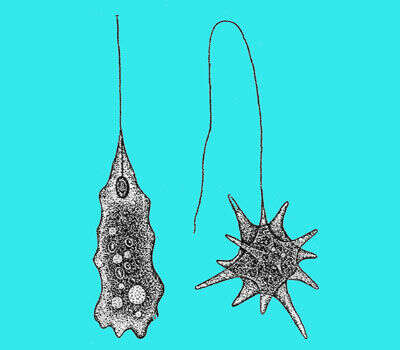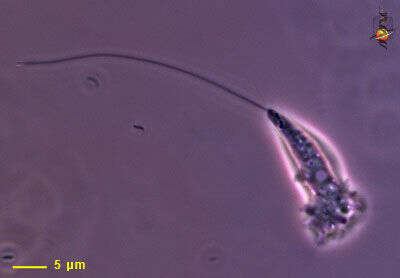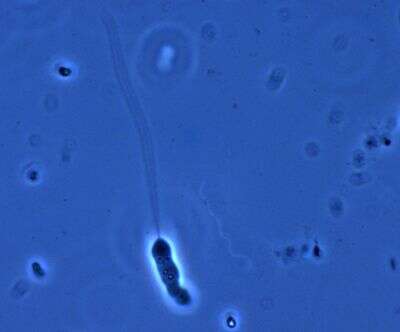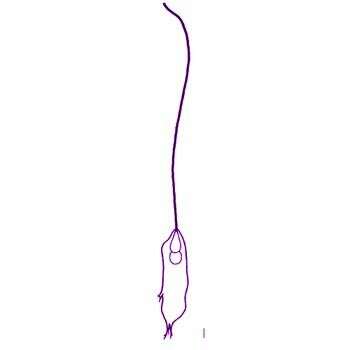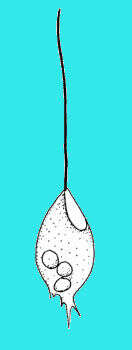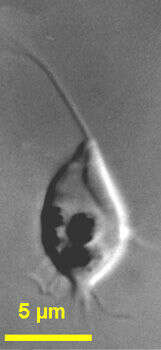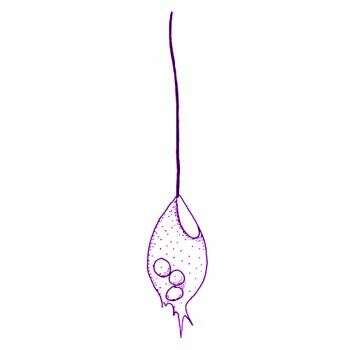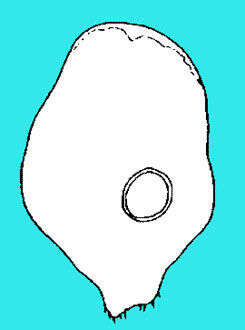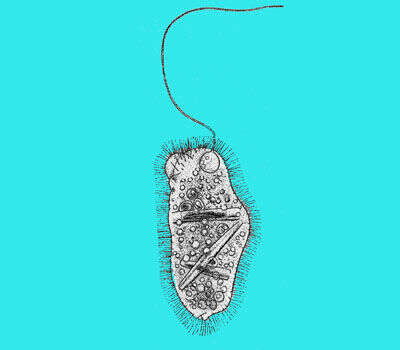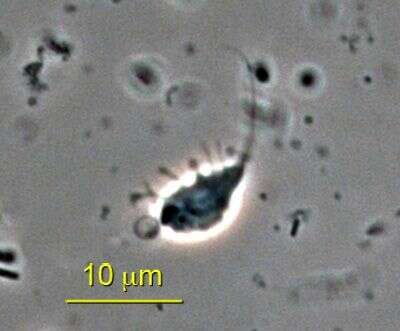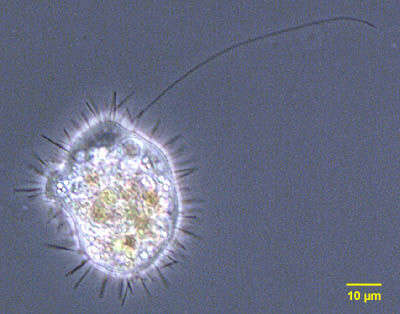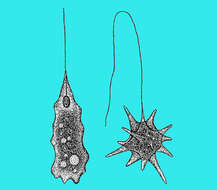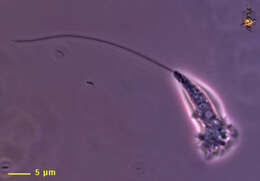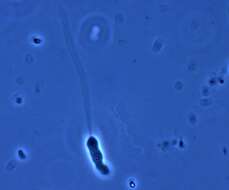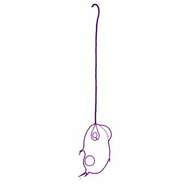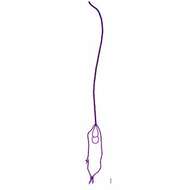-
Mastigamoeba simplex.
-
Lael D. Barlow, Eva Nývltová, Maria Aguilar, Jan Tachezy, Joel B. Dacks
Wikimedia Commons
Description: English: Localization for Mastigamoebe balamuthi COPI-β. Structured illumination microscopy of M. balamuthi labelled with antibodies againstCOPI and PDI (left, ER structure),COPI and MDH (middle, hydrogenosomes), andCOPI and α tubulin (right).The COPI signal is observed in numerous vesicles scattered within the M. balamuthi cells. α tubulin antibody labelled the tubular conus around nuclei and network of fibers. Signal for PDI network is concentrated around multiple nuclei. Graphs show line scans for fluorescence intensities corresponding to the dotted lines in merged images. Scale bar, 5 μm. Date: 7 March 2018. Source: Fig. 2 at
https://bmcbiol.biomedcentral.com/articles/10.1186/s12915-018-0492-9 A sophisticated, differentiated Golgi in the ancestor of eukaryotes
doi:10.1186/s12915-018-0492-9 (rearranged extract). Author: Lael D. Barlow, Eva Nývltová, Maria Aguilar, Jan Tachezy, Joel B. Dacks.
-
Mastigamoeba aspera Scale bar indicates 25 µm. Collected from a pond near the Bodden bay Schwarzer Peter in the southern part of the isle Hiddensee (German Baltic Sea). Sampling date 10/2018. The image was built up using several photomicrographic frames with manual stacking technique. Images were taken using Zeiss Standard with Olympus OM-D M5 MKII. Image under Creative Commons License V 3.0 (CC BY-NC-SA). Place name: Pond near the Bodden bay Schwarzer Peter, Hiddensee (German Baltic Sea) Latitude: 54.514946 Longitude: 13.082471 Multiebenen-Abbildung, manuell gestapelt. Der Messbalken markiert eine Länge von 25 µm. Probe aus einem Teich nahe der Boddenbucht Schwarzer Peter auf Hiddensee. Datum der Aufsammlung: 10/2018. Mikrotechnik: Zeiss Standard, Kamera: Olympus OM-D M5 MKII. Creative Commons License V 3.0 (CC BY-NC-SA). For permission to use of (high-resolution) images please contact postmaster@protisten.de.
-
Mastigamoeba aspera Scale bar indicates 25 µm. Collected from a pond near the Bodden bay Schwarzer Peter in the southern part of the isle Hiddensee (German Baltic Sea). Sampling date 10/2018. The image was built up using several photomicrographic frames with manual stacking technique. Images were taken using Zeiss Standard with Olympus OM-D M5 MKII. Image under Creative Commons License V 3.0 (CC BY-NC-SA). Place name: Pond near the Bodden bay Schwarzer Peter, Hiddensee (German Baltic Sea) Latitude: 54.514946 Longitude: 13.082471 Multiebenen-Abbildung, manuell gestapelt. Der Messbalken markiert eine Länge von 25 µm. Probe aus einem Teich nahe der Boddenbucht Schwarzer Peter auf Hiddensee. Datum der Aufsammlung: 10/2018. Mikrotechnik: Zeiss Standard, Kamera: Olympus OM-D M5 MKII. Creative Commons License V 3.0 (CC BY-NC-SA). For permission to use of (high-resolution) images please contact postmaster@protisten.de.
-
Mastigamoeba aspera Scale bar indicates 25 µm. Collected from a pond near the Bodden bay Schwarzer Peter in the southern part of the isle Hiddensee (German Baltic Sea). Sampling date 10/2018. The image was built up using several photomicrographic frames with manual stacking technique. Images were taken using Zeiss Standard with Olympus OM-D M5 MKII. Image under Creative Commons License V 3.0 (CC BY-NC-SA). Place name: Pond near the Bodden bay Schwarzer Peter, Hiddensee (German Baltic Sea) Latitude: 54.514946 Longitude: 13.082471 Multiebenen-Abbildung, manuell gestapelt. Der Messbalken markiert eine Länge von 25 µm. Probe aus einem Teich nahe der Boddenbucht Schwarzer Peter auf Hiddensee. Datum der Aufsammlung: 10/2018. Mikrotechnik: Zeiss Standard, Kamera: Olympus OM-D M5 MKII. Creative Commons License V 3.0 (CC BY-NC-SA). For permission to use of (high-resolution) images please contact postmaster@protisten.de.
-
Mastigamoeba aspera Scale bar indicates 25 µm. Collected from a pond near the Bodden bay Schwarzer Peter in the southern part of the isle Hiddensee (German Baltic Sea). Sampling date 10/2018. The image was built up using several photomicrographic frames with manual stacking technique. Images were taken using Zeiss Standard with Olympus OM-D M5 MKII. Image under Creative Commons License V 3.0 (CC BY-NC-SA). Place name: Pond near the Bodden bay Schwarzer Peter, Hiddensee (German Baltic Sea) Latitude: 54.514946 Longitude: 13.082471 Multiebenen-Abbildung, manuell gestapelt. Der Messbalken markiert eine Länge von 25 µm. Probe aus einem Teich nahe der Boddenbucht Schwarzer Peter auf Hiddensee. Datum der Aufsammlung: 10/2018. Mikrotechnik: Zeiss Standard, Kamera: Olympus OM-D M5 MKII. Creative Commons License V 3.0 (CC BY-NC-SA). For permission to use of (high-resolution) images please contact postmaster@protisten.de.
-
Mastigamoeba (massed-ig-a-me-ba) One of about 5 genera of pelobionts. These organisms are unusual in lacking mitochondria, dictyosomes and were for some time regarded as the most primitive of all eukaryotes. Most species which have been studied can adopt a variety of morphologies - including flagellates, amoebae, and cysts. The flagellates typically have one very long flagellum which beats in a fairly ineffectual fashion - and mostly progress by gliding. Body of cell most usually adopts an amoeboid form - such as that illustrated here. Typically found in habitats with little or no oxygen. Phase contrast.
-
Mastigamoeba (massed-ig-a-me-ba) One of about 5 genera of pelobionts. These organisms are unusual in lacking mitochondria, dictyosomes and were for some time regarded as the most primitive of all eukaryotes. Most species which have been studied can adopt a variety of morphologies - including flagellates, amoebae, and cysts. The flagellates typically have one very long flagellum which beats in a fairly ineffectual fashion - and mostly progress by gliding. Body of cell most usually adopts an amoeboid form - such as that illustrated here. Typically found in habitats with little or no oxygen. Phase contrast.
-
Mastigamoeba (massed-ig-a-me-ba) One of about 5 genera of pelobionts. These organisms are unusual in lacking mitochondria, dictyosomes and were for some time regarded as the most primitive of all eukaryotes. Most species which have been studied can adopt a variety of morphologies - including flagellates, amoebae, and cysts. The flagellates typically have one very long flagellum which beats in a fairly ineffectual fashion - and mostly progress by gliding. Body of cell most usually adopts an amoeboid form. Typically found in habitats with little or no oxygen. Phase contrast.
-
-
-
This cell is typical of many smaller mastigamoebae. There is a single long anterior flagellum, a tapering body that is capable of producing pseudopodia. identities of taxa in this area are not clear as many large species can produce smaller forms at certain stages in the life cycle. Phase contrast microscopy.
-
Small cell, one very long flagellum extending from a more homogeneous anterior region of the cell (this is where the nucleus is). The rest of the cell has inclusions. the body is flexible or amoeboid. Phase contrast microscopy.
-

Mastigamoeba punctachora Bernard et al., 2000. With flagellated and non-flagellated cells, 6 - 90 microns long. Cysts were occasionally observed. The outline of the cell is highly variable. The flagellum, when present, is normally 50-80 microns, but may be considerably shorter. The basal region of the flagellum is often slightly thickened and stiffened. Flagellated cells have typically one, conical nucleus, with the flagellum inserting at the point, although the nucleus was occasionally observed further away from the apparent flagellar insertion site. The nucleus contains a conspicuous nucleolus. Nuclei often ontain a granule, usually refractile and usually located to the ab-flagellar side of the nucleolus. Non-flagellated cells with up to eight nuclei, but most usually with one. Pseudopodia are generally rounded and broad, and may emerge as hyaline eruptive structures near the base of the flagellum. Fine conical or branching pseudopodia may also be formed, most commonly from the posterior end. Microtubules and endoplasmic reticulum present, usually around the nucleus. The cytoplasm often contains granules and food vacuoles. Generally one contractile vacuole, but several may occur, especially in the non-flagellated and multinucleate forms. The contractile vacuoles form by fusion of small vesicles and are usually located posteriorly. Occasionally particles adhere to the surface of the cell. Swimming cells are usually globular, less commonly elongate, and swim slowly with the flagellum directed anteriorly. Flagellated and non-flagellated cells may glide on the substrate.
-
Mastigamoeba schizophrenia Simpson et al., 1997. Cells with adhering paired nuclei and encountered as flagellated and non-flagellated amoebae or cysts. The flagellated cells are 7 to 25 microns long (average 11.6, n=14), and have a single pair of nuclei. The length of the flagellum is highly variable but usually considerably longer than the cell body. The cytoplasm appears smooth and homogeneous although granules and endoplasmic reticulum were sometimes observed. The non-flagellated forms are 12 to 70 microns (average 41.9, n=8) long and have one to five pairs of nuclei. Cysts are roughly spherical and are 12-13 microns across, with a single pair of nuclei. During swimming the flagellum is directed anteriorly and as with other pelobionts studied here, generates tip-to-base waves. Cells, flagellated and non-flagellated, may glide slowly in an elongate configuration.
-
-
Mastigamoeba (ma-stig-a-me-ba) simplex Kent, 1880. Cells are about 8 microns long with very flexible amoeboid cell body. Pseudopodia are produced from the sides and posterior parts of the cell. One emergent flagellum is about 20 microns long and thickened. The flagellum is directed forwardly and beats stiffly. The nucleus is located in the anterior part of the cell. Rarely observed.
-
Mastigamoeba simplex Kent, 1880. Flagellated and non-flagellated forms occur, rounded to elongate, 5 to 21 microns long, fagellated cells are usually ovoid to elongate, with the flagellum up to 40 microns long. The bulk of the nucleus is often located about one third of the cell away from the apex, although an extension of the nucleus connects to the base of the flagellum (this can be difficult to see). Inclusions may be present, although the anterior-most region of the cell is usually hyaline. Some eruptive formation of pseudopodia occurs in the region of the flagellar insertion. Fine, sometimes branching, pseudopodia may also form, especially from the posterior end, sometimes forming a pronounced tail by which the cell attaches to the substrate. When swimming, the flagellum is directed anteriorly. A contractile vacuole in freshwater isolates, usually located posteriorly, and filled by fusion of smaller vesicles.
-
-
-
Synonym - Phreatamoeba balamuthi. Isolated from Gambia. ATCC 30984.
-
ATCC 30984.
-
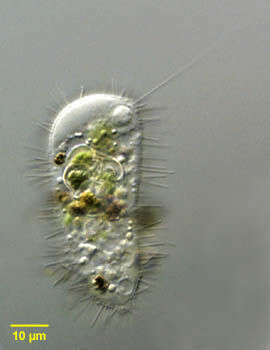
Portrait of Mastigina setosa a flagellated pelobiont. The ameboid monopodial cells have radiating "setae" which are 6-10 micron long filaments each of which has a basal granule (seen in this image). There is a single, long, lazily beating flagellum, which is closely associated with the nucleus (seen at the 12 o clock position adjacent to the cell membrane in this image). Electron microscopy shows the base of the flagellum connected to the nucleus by a cone of microtubules. The flagellum has a variable arrangement of microtubules. The nucleus contains a large endosome. Ingested algae are seen in food vacuoles. There is vigorous cytoplasmic streaming resulting in ameboid locomotion. The flagellum appears to contribute little to motility. Mastigina and the other pelobionts lack mitochondria and dictyosomes. Obvious ameboid locomotion and cytoplasmic streaming may help differentiate Mastigina from Mastigamoeba, a similar pelobiont. From slow-moving organically enriched freshwater runoff stream near Boise, Idaho. Differential interference contrast. Differential interference contrast optics.
-
Portrait of Mastigina setosa a flagellated pelobiont. The ameboid monopodial cells have radiating "setae" which are 6-10 micron long filaments. There is a single, long, lazily beating flagellum, which is closely associated with the nucleus (seen at the 1 o clock position adjacent to the cell membrane in this image). Electron microscopy shows the base of the flagellum connected to the nucleus by a cone of microtubules. The flagellum has a variable arrangement of microtubules. The nucleus contains a large nucleolus. Ingested algae are seen in food vacuoles. There is vigorous cytoplasmic streaming resulting in ameboid locomotion. The flagellum appears to contribute little to motility. Mastigina and the other pelobionts lack mitochondria and dictyosomes. Obvious ameboid locomotion and cytoplasmic streaming may help differentiate Mastigina from Mastigamoeba, a similar pelobiont. From slow-moving organically enriched freshwater runoff stream near Boise, Idaho. Phase contrast.



